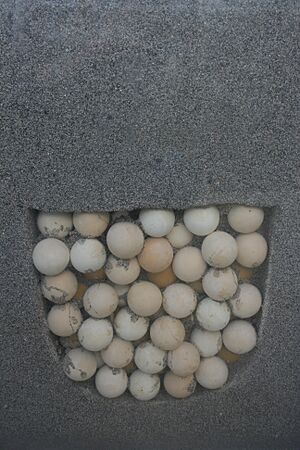Clutch (eggs) facts for kids
A clutch is a group of eggs laid by animals like birds, amphibians, or reptiles. These eggs are often laid all at once, usually in a nest. Think of it like a batch of eggs!

Sometimes, if a clutch of bird eggs is destroyed by predators, or if humans carefully remove them (like for special breeding programs), the female might lay another clutch. This is called double-clutching. This method can help increase the number of eggs a species produces. For example, it's used to help increase the population of rare birds like the California condor.
Contents
How Many Eggs in a Clutch?
The number of eggs in a clutch can be very different from one species to another. Sometimes, even within the same animal group, the clutch size can vary. Many things can affect how many eggs an animal lays.
What Affects Clutch Size?
Several factors can change the size of a clutch:
- Where they live: The habitat and environment can play a role.
- Health: A healthy animal might lay more eggs than one that isn't feeling well.
- Food: How much food is available for the parents and future babies.
- Predators: If there are many predators around, an animal might lay fewer eggs.
- Time of year: The season can also influence clutch size.
For birds, the number of eggs can also depend on the female's age and health, or how well the male can help find food. Some birds always lay a specific number of eggs. Animals that live a long time often have smaller clutches than those that have shorter lives.
Research on Clutch Size
A scientist named David Lack studied how birds decide how many eggs to lay. He suggested that for birds whose babies need a lot of care (like baby robins), the clutch size is limited by how many young the parents can feed until they are ready to fly.
For birds whose babies are more independent soon after hatching (like baby ducks), Lack thought the clutch size was based on the nutrients the mother had available to make the eggs.
For example, a study on brant geese showed that laying too many eggs wasn't helpful. If a goose laid more than five eggs, the chances of a gosling (baby goose) successfully growing up and flying away actually went down. This suggests that laying five eggs is the best number for these geese.
Gallery
-
Mallard (Anas platyrhynchos), a very large clutch, possibly from two females
-
Great black-backed gull (Larus marinus), a small clutch
-
Masked lapwing (Vanellus miles), a typical clutch
-
Common moorhen (Gallinula chloropus), a small clutch
-
Lesser spotted eagle (Aquila pomarina), a typical clutch
-
Feral pigeon (Columba livia domestica), a typical clutch
-
European starling (Sturnus vulgaris), a typical clutch
-
European goldfinch (Carduelis carduelis), a large clutch
-
Northern dusky salamander (Desmognathus fuscus), a typical egg clutch
See also
- Litter (zoology)
- Oology
- Viviparity










